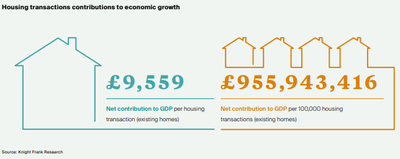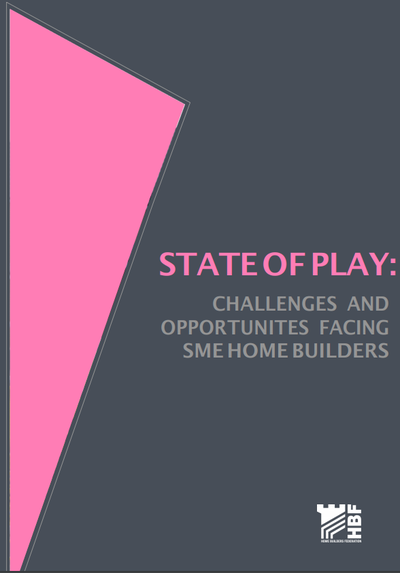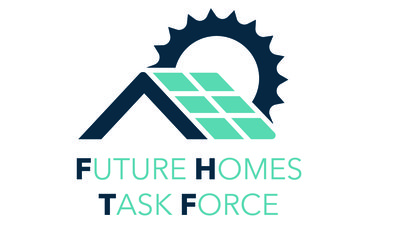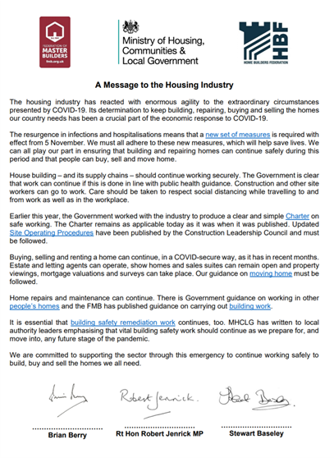Tue 24 November, 2020
Introduction
The coronavirus pandemic has affected so many lives and livelihoods during 2020 and its impact on the home building industry has been no different. This newsletter provides an update on HBF and the home building experience's and challenges over the course of the year and explains how the sector is working hard to ensure we can continue to deliver much-needed new homes this year and beyond.
Looking ahead to 2021, we also explore the ways in which the industry can deliver more for the economy and local communities in which its build. In this regard, we hope you will be interested in recent research we have published with Knight Frank looking at the economic benefits of wider housing market activity.
In this autumn edition of HBF’s Parliamentary Newsletter, we update you on our work to address one of the other biggest challenges facing us all: the environment and climate change. Information can also be found on the progress of the New Homes Ombudsman, the need for more retirement homes and the obstacles facing SME developers.
We hope you find it a useful update on the home building industry’s activities and priorities but if you have any questions or would like to an issue in more detail, please contact:
- David O’Leary, Policy Director: david.oleary@hbf.co.uk
- Emma Ramell, Policy and Public Affairs Manager: emma.ramell@hbf.co.uk
- Laura Markus, Policy and Public Affairs Officer: laura.markus@hbf.co.uk
Further information can also be found on our website www.hbf.co.uk.
About HBF
The Home Builders Federation (HBF) is the representative body of the home building industry in England and Wales. Our members are responsible for providing around 80% of all new private homes built in England and Wales and most of our members are small or medium-sized enterprises.
Industry update
Report highlights the economic benefits generated by housing market activity
In partnership with property consultants Knight Frank, HBF published a report in November exploring the broad range of economic benefits generated by the overall housing market. The report provides a quantitative figure for the impact of the housing market and found:`
- For every 100,000 housing transactions, there is an additional £1bn in Gross Value Added (GVA)
- This in turn supports more than 11,500 jobs, either directly or indirectly
Although the housing market has been generally robust since it reopened in May, supported by pent up demand and the introduction of the Government’s Stamp Duty holiday, it is reasonable to assume that this boost to activity will not last indefinitely. Over the past decade, overall property transaction numbers have remained significantly lower than pre-Financial Crisis norms. For instance, prior to 2007, typically 6-7% of all homes would transact each year. In recent years, this has been closer to 4%. Since 2013, the market has been boosted by a higher percentage of new build transactions due to the success of the Help to Buy scheme.
The stamp duty holiday comes to a close at the end of March 2021, coinciding with the end of the current Help to Buy scheme and the Coronavirus Job Retention Scheme.
Given the integral role the housing market plays in the economy, it is vital that we keep transactions moving in order to support the country’s economic recovery from the coronavirus pandemic.
The report can be found here.
SME house builders face tough battle ahead as growth and delivery projections fall, finds new HBF/Close Brothers Property Finance report
Many businesses have been affected by the coronavirus pandemic, including the home building industry.
While developers of all sizes are looking to mitigate the impacts of Covid-19, a new survey conducted by HBF in collaboration with Close Brothers Property Finance has found small and medium-sized enterprise (SME) home builders in particular are set to face considerable challenges over the coming months.
A summary of the survey’s findings can be found below:
- Growth projections: Two thirds of SME house builders (65%) have said their growth projections are down due to COVID-19. Of this figure, 39% of respondents said their growth projections are down between 10-50%, with over a quarter (26%) seeing their growth projections fall between 0-10%.
- Help to Buy: 76% of SMEs use Help to Buy and the regional thresholds under the new scheme are expected to prove to be a barrier, with a number of respondents highlighting challenges in their specific regions.
- Planning: According to 83% of respondents, planning delays and securing permission will remain a major barrier to housing delivery over the next 12 months.
- Government financial support: Just over half of respondents (53%) reported attempts to access support through CBILS and of these, only 44% of respondents had been successful, with others reporting numerous challenges including delays, inconsistent approaches from lenders and a refusal by some to lend to the real estate sector.
Recommendations
When SME developers were asked how the Government could further support their businesses, one of the most frequently mentioned recommendations was for the 2021-23 Help to Buy scheme price caps to be recast. This would ensure more potential homebuyers in high demand areas in all regions have the same support onto the housing ladder.
Commenting on the report, HBF’s Executive Chairman, Stewart Baseley, said: “As we look to boost housing supply post the coronavirus lockdown it is vital we support SME builders such that they can play their part. Increased bureaucracy and regulation and a harsh operating environment has seen the number of SME builders plummet in recent decades.”
The report can be read in full here. If you would like to discuss the survey’s findings in more detail, please contact HBF’s Policy Director, David O’Leary: david.oleary@hbf.co.uk, 07891 167 072.
SME home builder facts
|
Further information about the challenges facing small developers can be found in HBF’s 2017 report, Reversing the decline of small house builders.
Home builders launch Future Homes Task Force to achieve environmental ambitions
The environmental agenda is one of HBF’s top policy priorities and so in September we were delighted to hold our second Housing and Environment Summit to mark the launch of the Future Homes Task Force.
The overarching goal of the Taskforce is to develop a roadmap for the delivery of home building’s contribution to meeting national environmental targets and objectives on Net Zero, the natural environment, resources, heating, water and air quality, in a way that is workable for industry.
Its membership comprises representatives from all sectors with a role in the development of new homes, including government, house building, utility provision, material suppliers and environmental groups. The Task Force will also look at establishing a fully funded Delivery Hub to implement the roadmap and drive this work forward on a day to day basis.
Discussion at the Summit highlighted the need for cross-party support to provide confidence for investment in innovation and solutions, the need for collaboration with the finance sector and measures to support SMEs in managing change.
The home building industry is absolutely committed to achieving progress in these areas and so the Task Force will produce its recommendations for a route map and the establishment of a Delivery Hub by the start of next year.
Further information about our work in this area can be found on our website. Please contact Policy and Public Affairs Manager, Emma Ramell at emma.ramell@hbf.co.uk, 07732 682112, if you have any questions.
New report highlights the scale of developer contributions made to local communities
In September, HBF launched a new report Building Communities: Making Place a Home, which highlighted the extent to which home builders support and invest in the local communities in which they build. The report found developer contributions to communities through Section 106 agreements and other mechanisms in the last year has been over £7 billion, demonstrating the key role the industry plays in community investment.
Some of the key findings are as follows:
- Affordable housing provision
In 2018/19, home builders provided over £7 billion to local authorities in contributions for affordable housing and built 57,485 new affordable homes.
- Boosting education services
Home builders contributed over £200 million to educational facilities. This is enough to fund the recruitment of 8,500 new teachers, or to supply textbooks for over 25,000 schools.
- Supporting local health provision
Through tax revenue alone, £559 million was spent on improving health facilities last year. This is enough to fund over 6,300 new GPs, 18.6 million GP appointments, or 151,000 hip replacement operations.
- Driving local economies
Last year, private sector home building supported and sustained approximately 772,000 jobs and 8,400 graduate and apprenticeship positions. It also contributed £3 billion in tax revenues which is enough to fund over 25,000 miles of new road.
- Improving community facilities
Home builders contribute £45 million a year in local community spaces. That is enough to build approximately 400 football or rugby pitches, or 50 new sports halls.
- Enhancing green spaces
Home builders invested over £74 million in creating green spaces last year. This is enough to plant 8.65 million trees.
Despite these vast contributions, polling from YouGov published alongside the report found that only 37% of people associate a housing development with a financial contribution from developers, while 73% associate a housing development with increased pressure on facilities and services.
As such, the report sets out a series of recommendations to help raise awareness of the industry’s influence on communities and to increase the support for new build housing. The recommendations included:
- A public badging scheme, labelling all community assets which were funded by developer investment, which can be done via an easily visible 'blue plaque' or sign
- For unspent developer contributions to be given to the community directly rather than returned to the developer.
As housing input will fall this year due to the coronavirus pandemic (figures showed almost 40,000 fewer homes were built in Q2 2020 compared to Q2 2019), this will inevitably have a detrimental impact on the huge contribution development makes to community infrastructure and local economies. Consequently, it is vital that there is a renewed focus on housing policy to reduce the shortfall and to ensure that communities continue to enjoy the benefits of this investment.
Further information about our Building Communities campaign can be found on our website.
Progress update on the creation of a New Homes Ombudsman
HBF and its members are committed to delivering further improvements in the quality of new build homes and strengthened redress for buyers, including with the introduction of a New Homes Ombudsman Service (NHOS).
It is an agenda HBF has been working with a broad range of stakeholders on for some years now. Last Summer, we appointed Natalie Elphicke as the independent ‘New Homes Quality Champion’ to lead on the work and oversee the creation and introduction of a NHOS.
In May of this year the (interim) New Homes Quality Board was launched, with Ms Elphicke as its chair. This new independent body will sit at the centre of a new framework that will have responsibility for overseeing all aspects of quality and redress, including appointing an ombudsman.
The Board will be guided by principles of independence, transparency and integrity and its members include Nicholas Boys Smith, a co-chair of the Government’s Building Better, Building Beautiful Commission and Barry Cummins, National Development Director at Homes England. The remaining board members are made up of representatives from across the sector including from consumer bodies, housebuilders, warranty providers and lenders. The board will have a majority of non-industry (house builder and warranty provider) members.
Since its launch, workstreams have progressed quickly and the legal entity that will be the permanent New Homes Quality Board is now ready to be constituted.
The centre piece of the new arrangements will be a new industry code of practice that places far greater responsibilities on house builders. In particular, it aims to address the gaps in existing protections that were identified in a report by WPI Economics, who were commissioned by HBF in 2017 to undertake a review of the whole new homes redress process. The new code will include:
- A requirement for builders to provide more detailed information to customers during the sales process
- A tightened up final sign off process to ensure the home is ‘complete’ before mortgage money is released
- The option for a customer to take out a pre-completion inspection on their new home
- A responsibility for builders to deal with any snagging issues within a set time in years 1 and 2 of occupation.
A consultation process is about to get underway on the new draft Code.
The NHQB has now made a detailed initial application to the Ombudsman Association setting out the basis of how a NHOS will operate and be procured. The ambition is to have a NHOS in place in the first half of next year.
Government is being kept closely informed of the NHQB’s progress and proposals align with the requirements set out in the Draft Building Safety Bill. The NHQB has held discussion with the Welsh and Scottish Governments with the intention being that the new arrangements cover all of Great Britain.
While the new arrangements will pose some short-term challenges to the industry and will require significant changes to be made to how their businesses operate, it is something the industry fully supports and we firmly believe that in the longer term it will lead to huge benefits for both builders and consumers.
Further information can be found here. If you have any questions, please contact HBF’s Communications Director: steve.turner@hbf.co.uk, 07919 307760.
Data from Homes England shows Help to Buy producing a good return on taxpayers’ investment
Statistics published as part of Homes England’s annual report have, for the first time, demonstrated the financial performance of the Government’s Help to Buy equity loans issued since the scheme opened in 2013.
- 49,020 loans had been fully paid back by March 2020
- The return on investment for the taxpayer from the first 49,000 repaid loans was just over 10%
- The original value of repaid loans was £2.25bn, but Government received £2.5bn from them
- Receipts from repaid Help to Buy Equity Loans in 2019/20 totalled £941m from 18,375 loans
- The average value increase of loans repaid last year was 7.5%
- Around 60% of the equity loans issued in the first two years of the scheme’s operation were fully paid back by March 2020
Greater investment in retirement housing could help FTBs on to the property ladder

A new report by Homes for Later Living - a consortium made up of Churchill Retirement Living, McCarthy & Stone and Lifestory Group which operates alongside the retirement group of the HBF - has found that 25% of people aged 65 or over (approximately 3 million people) would like to downsize but are put off by factors such as the cost of moving and a lack of choice over suitable properties.
The Chain Reaction report calls for ministers to set a goal of building 30,000 retirement homes a year and for the Government to double down on the recent stamp duty cut and make this permanent for older people who are downsizing into specialist retirement housing. Additionally, the report found:
- Two in every three retirement properties-built releases a home suitable for a first-time buyer
- If 30,000 later living properties were built per year (10% of the Government’s overall housing target) this would mean at least 60,000 or more additional house moves are facilitated each year
- If 30,000 new retirement properties were built every year (up from 8,000 completions currently), this would generate savings to the NHS and social care services of as much as £2.1bn a year, as fewer people would end up being hospitalised or needing expensive care from preventable injuries such as falls.
The report is available to be read in full here.
HBF joint communique with MHCLG following the second lockdown announcement
Following the Prime Minister’s announcement on 31st October of the second national lockdown, HBF engaged with the Ministry of Housing, Communities and Local Government (MHCLG) to clarify the situation for the home building industry. While it was confirmed immediately that construction work was permitted to continue, it was unclear whether the housing market could remain open. During these discussions, HBF emphasised the importance of ensuring the housing market could continue during the period of restrictions and the benefits this would deliver for both the economy and home housing supply.
As such, we were pleased to publish a joint statement with MHCLG and the Federation of Master Builders on 3 November confirming that activity relating to the building, buying, selling and renting of a home can continue in accordance with health and safety measures and public health guidance.
The communique follows on from the Charter for Safe Working Practice, jointly published with MHCLG in May. Since its publication, the Charter has been signed up to by more than 100 of HBF’s home building members and has been supported by a number of allied organisations and builders merchants too. It is intended to be displayed publicly to ensure that communities are aware of the status of home building sites during the lockdown period and supports the very detailed protocols individual builders have in place to ensure safe working on sites.
The joint statement can be read here.




